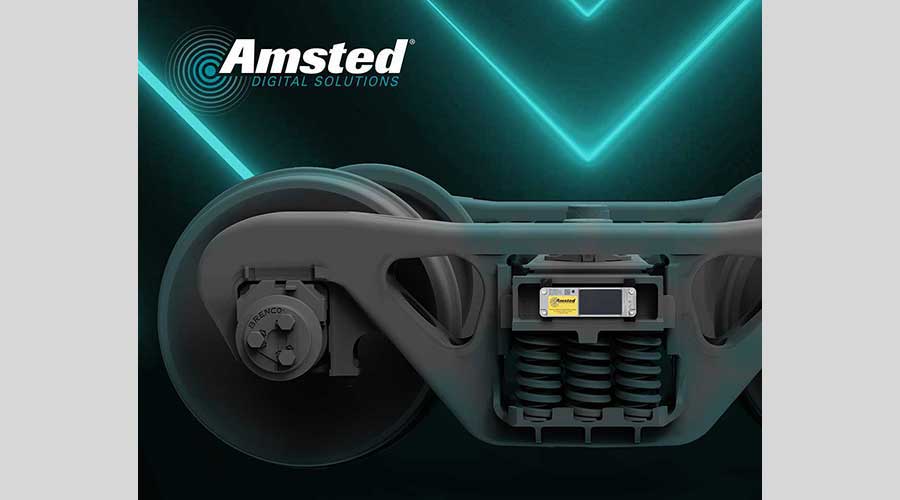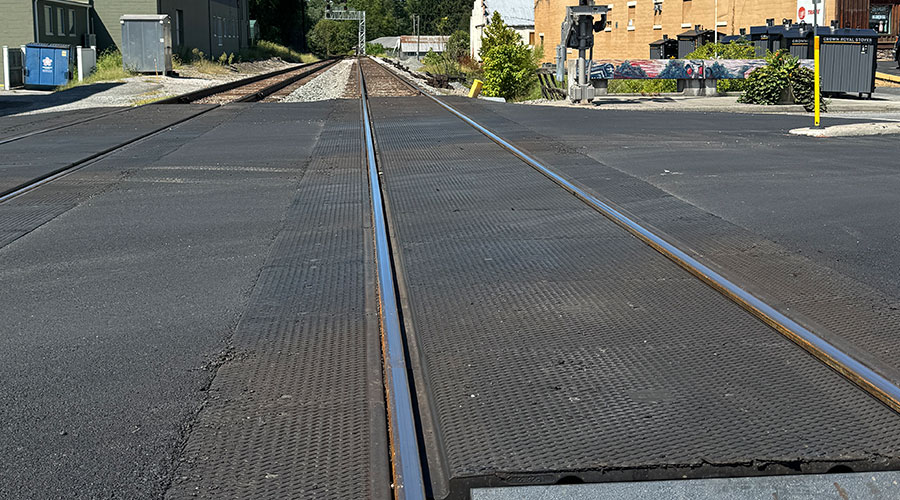Stay updated on news, articles and information for the rail industry
July 2007
Rail News: C&S
A switched-on marketplace
For George Rudge, the proof that the switch machine market’s hot is in the building: specifically, the new one nearing completion at his company’s 184,000-square-foot Batesburg, S.C., manufacturing plant.
“We’re making 200 switch machines a month — we’re at history-making levels,” says Rudge, director of component marketing for Union Switch & Signal Inc. (US&S) Robust capital spending from North American railroads, burgeoning overseas markets and new safety requirements from U.S. rail regulators continue to drive demand for switch machines and switch monitoring and control technology.
And the demand looks strong at least into 2008, suppliers say.
“The railroads are making back their costs of capital and they’re investing it in areas that will continue to improve their capacity,” says Rudge.
For US&S, that means strong demand for its M-Style switch machines, the M-3E and M-23E, which are used by all the Class Is, although there’s been a bit more interest coming from the western roads, Rudge says.
The M-3E and M-23E are equipped with a solid-state electronic circuit controller; all serviceable parts can be maintained with one tool — a ratchet with a 3/4-inch socket and 10-inch extension, according to US&S literature.
Both machine types feature a low vertical profile, integrated latch-stand assemblies, local/remote control capability and self-lubricating bearings. And, they offer interchangeability with other switch machines.
“They’re reliable, field-tested products,” Rudge says.
Supply's in demand
By summer’s end, US&S will have enough extra capacity at its Batesburg plant to accommodate the steady North American business and meet increasing overseas demand. The supplier, which has been an active switch machine seller in Australia, landed three contracts earlier this year from transit systems in Italy and Greece.
And when it comes to switch monitoring in dark territory, US&S offers two products as part of its Dark Territory Switch Solutions line. Via the “Switch Monitoring & Control” and “Island of Train Control” product suites, train crews can be notified of any switch that isn’t properly positioned for movement at or before safe-braking distance.
Both solutions electronically enable remotely controlled mainline switch machines from the locomotive.
Dark territory switching is becoming an increasing concern for railroads, in part due to increasing Federal Railroad Administration (FRA) scrutiny.
Many roads are working to satisfy the requirements of FRA Emergency Order 24, which was issued in October 2005 and requires railroads to re-train employees on proper switching in dark territory.
Permanent switching requirements likely will be incorporated into a final rule to prevent human factor-caused train accidents, scheduled to be published later this year, according to the FRA.
For Global Rail Systems Inc., the emphasis on dark territory switching has prompted more interest in the supplier’s offerings.
“This is a technological company that is entrenched in wireless technology, and that’s where a lot of things are happening,” says Chief Executive Officer Tom Schlosser. “It’s smarter to automate the railroads instead of adding more assets.”
One of Global Rail Systems’ popular products is the FAS-PAS™ (Fail Safe Audible Signal-Power Activated Switch), which is designed to enable train crews and dispatchers in dark territory to determine the positions of turnouts and activate switches via remote control.
In addition to satisfying FRA requirements, the system doubles as time and fuel saver, Schlosser adds.
For the Missouri & Northern Arkansas Railroad, the use of FAS-PAS permits four locomotives a day to skip the time- and fuel-consuming step of having train crews stop and manually throw a switch.
And Kansas City Southern Railway has 20 FAS-PAS locations set up along the Meridian Speedway, where 12 trains pass per day. The systems have helped KCS double capacity on the corridor, Schlosser says.
The ability to tap technology to boost capacity has caught the attention of more and more railroads, including short lines. Global Rail Systems is working on a scaled-down version of FAS-PAS that would be more affordable for smaller railroads, says Schlosser, a former short-line executive.
Bottom line: Things are hopping at Global Rail Systems. In May, the company acquired Signal Innovations, which provides train detection systems used in Global Rail’s mainline and yard automation products. The company also has expanded its Marlin, Texas, manufacturing facility, and added sales staff and product engineers, and is exploring markets in Brazil, South Africa, China, Saudi Arabia and the Czech Republic, Schlosser says.
A ‘vital’ development
Also taking aim within the dark territory market is GE - Transportation. The company’s Switch Guard provides vital monitoring of switches and other devices in dark territory.
Key to the Switch Guard’s success is the Mini Vital Controller, which was formally launched in May. During the past year, GE had been working to develop a prototype monitoring unit, says Derald Herinckx, product/unit leader of GE’s Wayside Signaling Products.
The initial response from Class Is that have seen demonstrations or tested the units has been positive, he adds.
The Mini Vital Controller also can be solar powered, says James Guthrey, product manager for GE’s Structure and Switch Machines. Both the Switch Guard and Mini Vital Controller can be used with any GE switch machine.
“What direction we get from the railroads on how to apply it depends on what further direction the railroads get from the FRA,” Guthrey says. “[The Mini Vital Controller] really enhances the control and monitoring capabilities of switches in dark territory.”
Fixating on customer focus
And because the Mini Vital Controller is based on GE’s long-existing ElectroLogIXS™ wayside monitoring platform, the new system will inherit much of the existing system’s capabilities, such as Web-based remote diagnostics, Herinckx adds.
Like other switch machine and switch monitoring suppliers, Safetran Systems Corp. continues to benefit from increased freight and passenger railroad spending aimed at upgrading capacity. This includes an electrically powered yard switch machine, the SYM-10H, that operates as quickly as a pneumatic-type machine, and a mainline switch machine, the SML-20, that is a direct replacement for competing machines.
But Safetran also notes that dark territory switch monitoring continues to attract increased industry interest. The company’s Vital Safetran I/O Logic Controller (VSLIC) system of remote switch monitoring and control can be configured to provide both remote switch monitoring and control capability in conjunction with a power-operated switch.
VSLIC can also interface with wayside signals, the locomotive cab or a central dispatch location through a wide range of communications systems.
But dark territory isn’t railroads’ only switch-related concern. Railroads need equipment that can stand up to whatever Mother Nature dishes out. To that end, National Trackwork Inc. has introduced the Flood Guard™ line of switch machines and stands that are designed for difficult environments, says Bob Fiorio, vice president of sales.
“Our customers have told us they need a switch stand and machine that can give reliable performance even in standing water, such as a tunnel or in a mining application where water levels can fluctuate greatly and flood conditions can occur,” he says.
National Trackwork also has enhanced the remote control capabilities of its Trackwork Model 1500 and 1100 solar- and electric-powered switch machines. The use of a receiver on each switch machine allows an operator in a tower or on a locomotive with a transmitter to operate one or more switch machines with the touch of a button, Fiorio says. The expandable system can accommodate up to 18 switch machines from a single transmitter, he adds.
Designing with value in mind
At ALSTOM Signaling Inc., the emphasis is on product reliability and maintainability, which is what customers want, says Barry Wharity, vice president of sales and marketing.
Enter the GM4000A wayside switch machine and the TM100 in-tie switch machine: Both units feature new self-diagnostic tools with solid-state controllers that provide local control, as well as condition monitoring.
“We’ve designed and engineered our switch machines ... to dramatically reduce acquisition and maintenance costs in order to provide our customers with the best possible value,” Wharity says.
Design changes in the TM100 enabled the machine to integrate better with the track structure, eliminating the need for layout rods while allowing for mechanical tamping, which provides greater track stability and reduces maintenance.
The changes also recently helped ALSTOM land a three-year purchase agreement with a Class I, says Alberino Palozzi, Product Line Manager, Switch Machines, declining to name the railroad. And in response to customer demand, ALSTOM also recently developed a version of its Model 6 yard switch machine to accept AC power, Wharity says.
And even though switch machines represent a relatively small niche for Western-Cullen-Hayes Inc., the supplier continues to look for ways to improve its wares — and its responsiveness to customer requirements.
‘Slacking off’ isn't in the offing
The company’s “old reliable” is the electro-hydraulic WCHT-72 switch machine, which is designed to operate in yards and industrial switching areas, says Carl Pambianco, sales manager. But since Class Is such as BNSF Railway Co. are “interested in solar-powered machines,” Western-Cullen-Hayes is evaluating “a couple prototypes,” Pambianco says.
Count on suppliers to continue fixating on customer focus. Over the years, they’ve experienced the market’s cyclical swings and product-development shifts. They’ve learned to go with the flow. And in the switch-machine market, that flow is a surging current.
“We just needed to expand capacity,” US&S’ Rudge says. “We don’t see things slacking off.” 
Robert J. Derocher is a Loudonville, N.Y.-based free-lance writer.
Keywords
Browse articles on switch machine switch machines switch monitoring switch control C&S rail technologyContact Progressive Railroading editorial staff.


 LRW Honors Amtrak’s Acheson As Railway Woman Of The Year
LRW Honors Amtrak’s Acheson As Railway Woman Of The Year
 From Editor-In-Chief Foran: Of Gender Equity And Inclusion
From Editor-In-Chief Foran: Of Gender Equity And Inclusion
 Spotlight On Some Of Today’s Rail Safety Products
Spotlight On Some Of Today’s Rail Safety Products
 Women of Influence in Rail eBook
Women of Influence in Rail eBook
 railPrime
railPrime






